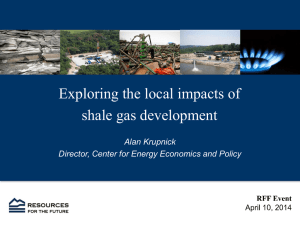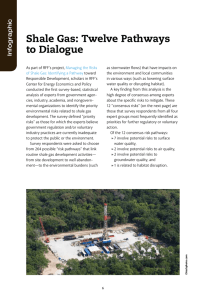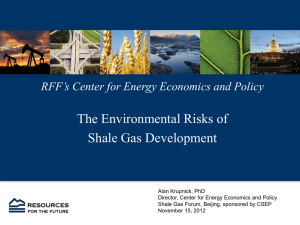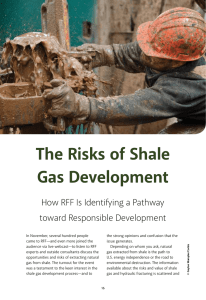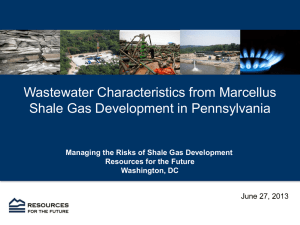Managing the Risks of Shale Gas: Research Findings
advertisement
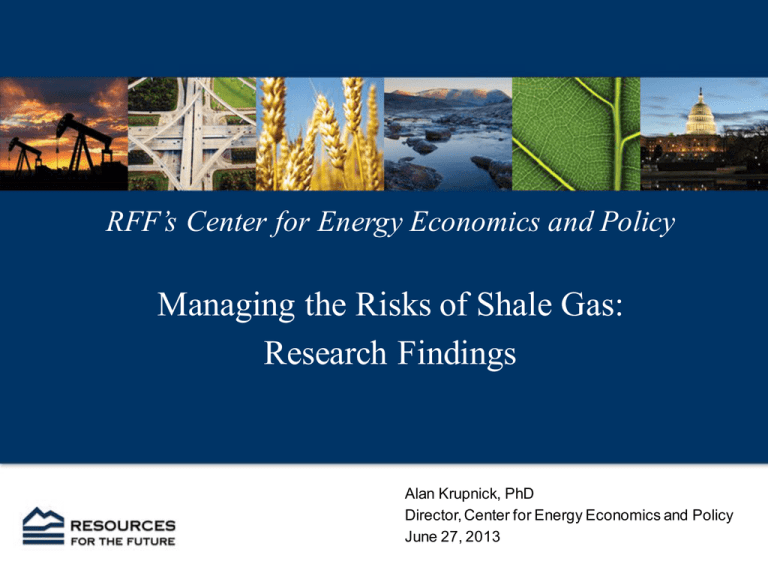
RFF’s Center for Energy Economics and Policy Managing the Risks of Shale Gas: Research Findings Alan Krupnick, PhD Director, Center for Energy Economics and Policy June 27, 2013 Acknowledgments • Funding from the Alfred P. Sloan Foundation • From RFF: Alan Krupnick (PI), Sheila Olmstead (co-PI), Lucija Muehlenbachs, Nathan Richardson, Jhih-Shyang Shih, Juha Siikamaki, Ziyan Chu, Hal Gordon, Madeline Gottlieb; Kristin Hayes (Assistant CEEP Director); Jan Mares; RFF Communications: Shannon Wulf, Pete Nelson, Adrienne Young, Jeannine Ajello, Nicole Hardy • Outside of RFF Researchers • Shimon Anisfeld, Yale University • Beia Spiller, Environmental Defense Fund • Chris Timmons, Duke University • Hannah Wiseman, Florida State University Advisors • Mukul Sharma, University of Texas • Karlis Muehlenbachs, University of Alberta • James Saiers, Yale University (also co-author) 2 Plan for the Event • Krupnick: Overview of our work on shale gas development risks and brief presentation of “familiar results” • Presentations of new results: • • • • Richardson: State by state regulatory results Olmstead: Chemical Assay results Muehlenbachs: Property Value study Siikamaki: Public Survey • Krupnick: Cross-cutting results and future research • Break • Panel of experts discussing utility of findings and future research 3 Risk Matrix 4 Creating Risk Pathways (Risk Matrices on the web) Intermediate Impacts Activities Burdens Site development and drilling preparation Air pollutants Groundwater Human health impacts Drilling fluids and cuttings Surface water Market impacts Vertical drilling Soil quality Ecosystem impacts Air quality Climate change impacts Horizontal drilling Saline water intrusion Fracturing and completion Fracturing fluids Well production and operation Flowback constituents (other than fracturing fluids) Flowback and produced water storage/disposal Produced water constituents Shutting-in, plugging and abandonment Condenser and dehydration additives Workovers Habitat/community disruptions Upstream and downstream activities Final Impacts Habitat disruption Quality of life impacts Community disruption Occupational hazard Other 5 Creating Risk Pathways (cont’d) Activities Burdens Intermediate Impacts Final Impacts Morbidity Conventional air pollutants and CO2 On-road vehicle activity Air quality Climate change impacts Noise pollution Community disruption Aesthetics Road congestion Time loss 6 Sloan Project on Environmental Risks 1. Expert survey of shale gas development risks Risk Matrix 2. Statistical analysis: a) Effects of shale gas activity on surface water quality in Pennsylvania b) Analysis of chemical assays of flowback/produced water c) Property Value effects 3. State-by-state regulatory analysis 4. Public Survey 5. Summary 7 Sloan Project on Environmental Risks Risk Matrix 1. Expert survey of shale gas development risks Complete 2. Statistical analysis: 4. Public Survey a) Effects of shale gas activity on surface water quality in Pennsylvania Complete, PNAS b) Analysis of chemical assays of flowback/produced water Available soon c) Property value. Complete 3. State-by-state regulatory analysis Complete (available today) Presented at AERE, Aspen Institute 5. Summary Complete (available today) 8 Surveying the Experts: Who & What? 215 experts: • • • • NGOs (35): Most national environmental groups, some local Academics (63): Universities/think tanks Government (42): Federal agencies; about half the relevant states; river basin commissions Industry (75): Operating and support companies, trade associations, consulting firms, law firms Chose high priorities among 264 possible routine risk pathways, 14 accident types. Overlap of each groups’ high priority routine risk pathways Consensus routine risk pathways 12 More detail Some surprises • • • Surface waters dominate Only two pathways (fracking fluids) are unique to the shale gas development process Habitat fragmentation included Some expected findings • • • • On-site pit and pond storage of flowback Freshwater withdrawals Venting of methane Treatment and release of flowback liquids What is not a frequently chosen pathway • Groundwater risks from fracking • Seismic risks Responsibility Who should be responsible for managing risks? Government Industry NGO Industry Academic Gov’t All experts 93.8% 49.4% 74.9% 74.8% 69.4% 6.2% 50.6% 25.1% 25.2% 30.6% • All groups prefer shared responsibility • For consensus pathways, majority of industry supports government responsibility Surface Water Quality Risk Study (PNAS, 2013) We exploit spatial and temporal variation in the proximity of shale gas wells, waste treatment facilities, and surface water quality monitors in Pennsylvania to statistically identify: • the impact of shale gas wells on downstream chloride and TSS concentrations; and • the impact of shale gas waste treatment and release to surface water on downstream chloride and TSS concentrations. 15 16 Conclusion • No statistically significant impact of shale gas wells on downstream Cl- concentrations. • A positive result here would have been consistent with systematic contamination problems from spills, etc. • Release of treated shale gas waste to surface water by permitted wastewater treatment facilities increases downstream Cl- concentrations. • Effect is more strongly associated with facilities affected by 2011 regulatory attention from PA DEP/EPA. • Shale gas well pads increase downstream TSS concentrations. 17 Thank You! www.rff.org/shalegasrisks 18

